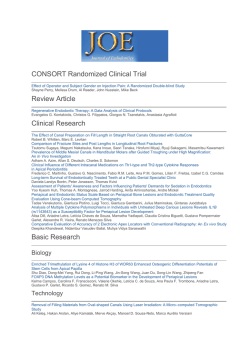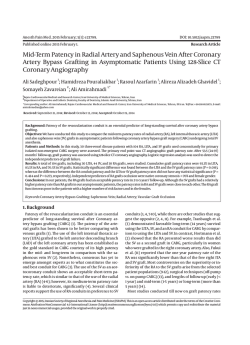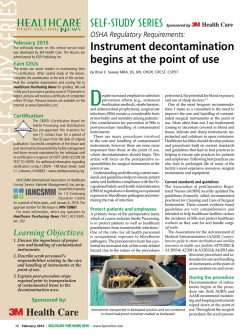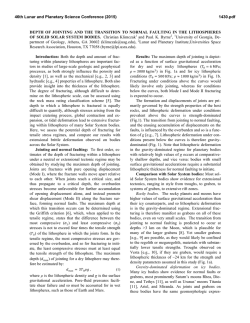
evaluation of apical foramen deformation produced by - SciELO
ACTA-2-2014:3-2011 24/10/2014 11:46 a.m. Página 77 77 EVALUATION OF APICAL FORAMEN DEFORMATION PRODUCED BY MANUAL AND MECHANIZED PATENCY MANEUVERS Gustavo Lopreite1, Jorge Basilaki1, Maria Romero, Pedro Hecht2 1 Department of Endodontics,2 Department of Biophysics.School of Dentistry, University of Buenos Aires, Argentina. ABSTRACT Achieving apical foramen patency through surgical maneuvers during the biomechanical preparation of root canals is a goal sought by several schools. The aim of this study was to evaluate the deformation of the foramen as a result of using stainless steel hand files and nickeltitanium rotary instruments for achieving patency. Forty recently extracted dental roots with single canals were calibrated to a length of 18 mm and mounted on acrylic blocks to enable study maneuvers. Each foramen was observed and mapped using SEM (Phillips high vacuum) at x 100, using Golden Ratio software (Softonic). Endodontic surgical preparation was subsequently performed on all samples to 1 mm from the foramen using the Protaper rotary system up to instrument F3. The samples were then divided into two groups of twenty for apical patency maneuvers: Group A (man- ual patency) on which stainless steel Flexofile (MailleferSuiza) hand files gauge .10 were used, and Group B (rotary patency) on which NiTi Pathfile (DentsplyMailleferSuiza) rotary instruments gauge .13 at 150 rpm, were used. The foramina were examined again using SEM, measured, mapped and compared with the previous images. A scale was established to evaluate the observations. Results were analyzed using the Mann Whitney test, which showed no significant difference between groups (p=0.110). It is concluded that under the conditions of this study, surgical apical patency maneuvers using stainless steel manual files or nickel titanium rotary instruments produced different degrees of foramen deformation, with no significant difference between methods. Key words: stainless steel; nickel-titanium alloy: root canal preparation EVALUACIÓN DE LA DEFORMACIÓN DEL FORAMEN APICAL PRODUCIDA POR MANIOBRAS DE PERMEABILIZACIÓN MANUALES Y MECANIZADAS fer-Suiza) calibre .10 y en las restantes 20 con instrumentos Pathfile (Dentsply-Maillefer-Suiza) de NiTi rotatorio calibre .13 a 150 rpm. Quedando conformados dos grupos: A (permeabilidad manual) y B (permeabilidad rotatoria). Los forámenes fueron nuevamente observados al MEB realizando las mediciones y mapeo comparativo con las imágenes previas. Se estableció una escala de valores para la evaluación de las observaciones. Los resultados se analizaron por medio de la prueba de Mann Withney, la que no arrojó diferencias significativas entre los grupos (p=0.110). Como conclusión, en las condiciones de este estudio, la realización de maniobras de permeabilización quirúrgica realizada por instrumentos manuales de acero o rotatorios de níquel titanio mostró diferente grado de deformación del foramen, sin presentar diferencias significativas entre ambos métodos. RESUMEN La permeabilización del foramen apical por maniobras quirúrgicas durante la preparación biomecánica de los conductos radiculares es una meta perseguida por diversas escuelas. El objetivo de este trabajo fue evaluar la deformación del foramen generada por la utilización de limas de acero inoxidable de empleo manual y níquel titanio rotatorio en las maniobras de permeabilización. Se emplearon 40 raíces dentales recientemente extraídas con un solo conducto. Se calibraron todas en 18 mm de longitud y se montaron en tacos acrílicos que permitieron la realización de las maniobras del estudio. Se observó y mapeó cada uno de los forámenes al MEB (Phillips de alto vacío) a x 100 y empleando el programa Golden Ratio (Softonic). Posteriormente se realizó en todas las muestras la preparación quirúrgica endodóntica hasta 1 mm de su foramen con el sistema rotatorio Protaper hasta el instrumento F3, se hicieron maniobras de permeabilidad apical en 20 raíces con limas manuales de acero inoxidable Flexofile (Maille- Palabras clave: acero inoxidable; aleación niquel-titanio; tratamiento de conductos INTRODUCTION Conceptually, the aim of maintaining apical patency is to prevent the foraminal lumen from being blocked by preexisting debris and debris produced during surgical preparation, in order to help keep the apical end of the root canal clean beyond the zone comprised between the ideal length established in surgical preparation and the actual foramen. This technique is advocated, developed and applied in teaching programs at a high percentage of schools that offer graduate and post-graduate degrees in endodontics 1. Vol. 27 Nº 2 / 2014 / 77-81 ISSN 1852-4834 Acta Odontol. Latinoam. 2014 ACTA-2-2014:3-2011 24/10/2014 11:46 a.m. Página 78 78 Gustavo Lopreite, et al. Buchanan describes the method, specifying that the gauge of the instrument used should be narrower than the canal between the constriction and the foramen, with the instruments of choice being ISO standard gauge .06,.08 or .10. The instrument should be passive, so it should have limited cutting capability. It must allow removal of debris from the apical tip without deforming the preexisting lumen of the foramen 2. The clinical procedure consists of using a narrow gauge instrument which reaches the foraminal length, going beyond the level of the apical constriction, without producing a shaping effect. It is recommended to introduce it alternately between irrigation steps and gauge changes of the shaping instruments, in order to prevent the apical foramen from becoming blocked with antigenic material, and to help irrigants and coadjuvants to reach slightly beyond the apical constriction 3,4. The instruments selected for this purpose may be hand operated or mechanical, and made of stainless steel or nickel-titanium alloys, the latter being the instruments of choice for mechanically operated instruments. Gauges should not be greater than ISO standard .15 with 2% taper so that they comply with the selection criteria of flexibility, elasticity and developing low restorative force. NiTi alloy metallographic properties make PathFile rotary instruments (Dentsply-Maillefer. Ballaiges, Switzerland) elastic and flexible. In addition, they are helical, have quadrangular cross-section, inactive tip, constant 2% taper and gauges .13, .16 and .19. These features make them a viable option for apical patency maneuvers, in addition to the tried and tested standardized stainless steel manual instruments. Instrument features must enable maneuvers to be performed passively, since cutting activity within the root canal beyond the apical constriction may cause over-preparation and unwanted deformation of the apical foramen. This has been assessed and analyzed by different authors with varying results.5 The aim of this study was to evaluate apical foramen deformation caused by stainless steel hand files and rotary nickel titanium instruments in surgical patency maneuvers. MATERIALS AND METHODS This experiment used dental roots selected according to the following inclusion criteria: recently extracted for orthodontic reasons, without prior lesions or treatments, fully developed apex, and a single canal considered straight according to Acta Odontol. Latinoam. 2014 Schneider’s method. The roots were preserved in 10% formalin until they were used. The crowns were cut off using a carborundum disc, using a standardized length of 18 mm from the apical tip. Rectangular prism-shaped blocks were made from photopolymerizable compound resin (TPH- DentsplyBrazil), and five root specimens were embedded each, so that their cervical accesses were lined up on one face, the cervical 14 mm remained embedded, and the apical 4 mm remained exposed. The samples were dehydrated and metalized for examination under SEM (Phillips 550- high vacuum mode). Root apices for all samples were examined at x100, photographed and the principal apical foramen mapped using Golden Ratio (Softonic) image managing software. Roots in which the main foramen measured 200 to 350 micrometers were selected for this study. Forty roots met the criteria, and were randomly divided into two groups of 20 specimens for processing. The root canals in all specimens were surgically prepared using the Protaper Universal system (Dentsply-Maillefer-Ballaigues-Switzerland), following the manufacturer’s instructions for sequence up to file F3, using a working length 1mm shorter than the length to the apical foramen. After the action of each file, the canal was irrigated with 2 ml 2.5% NaOCl and a 17% aqueous solution of EDTAC (Farmadental) as coadjuvant . Once the working length was achieved by the Protaper rotary instrument, apical patency was maintained in all cases by performing said maneuver between every change in instrument gauge throughout preparation. Twenty roots were treated using PATHFILE (Dentsply-Maillefer-Ballaigues-Switzerland) violet code, gauge .13 with mechanical continuous clockwise rotation at 150 rpm, with 1 Ncm torque, using an XSmart (Dentsply-USA) engine during introduction and immediate removal up to the length of the foramen. The rest of the specimens were treated using a steel hand file #10 (Maillefer- BallaiguesSwitzerland), by introduction and immediate removal up to the length of the foramen (Fig.1). Two groups were obtained: • GROUP A, mechanical surgical preparation; patency with stainless steel #10 hand file. • GROUP B, mechanical surgical preparation; patency with mechanical PATHILE .13. ISSN 1852-4834 Vol. 27 Nº 2 / 2014 / 77-81 ACTA-2-2014:3-2011 24/10/2014 11:46 a.m. Página 79 Foramen deformation for apical patency 79 After surgical preparation, the canals were irrigated with distilled water and dried with paper points. Then they were dehydrated, re-metalized and examined again under SEM on the same day. The prism-shaped blocks enabled the microscope stage to be repositioned exactly, thus enabling us to obtain images with the same incidence and magnification. The post-procedure foramina were reexamined under SEM at x100, measured and mapped, for comparison with the previous images. It was evaluated whether or not the original shape of the foramen had been preserved. A scale was established to interpret the data collected, to determine whether there had been any deformation of the lumen of the apical foramen with regard to the opening created, as a percentage with relation to the diameter of the instrument employed for apical patency. The photograph measuring software Golden Ratio (Softonic) was used, which provided relative values measured in pixels, calculated by comparing them to the standard bar on the image, in order to calculate the percentages evaluated. A score of 1 was assigned when there was no deformation, 2 when deformation was 1% to 25% of the size of the instrument, and 3 when it was 26% to 50% (Table 1). RESULTS The data were tabled for analysis (Table 2). Group A has a higher number of samples without deformation. The graphs show the distribution of values in each group. Group A has 13 specimens without deformation, 4 with level 2 deformation and 3 with level 3 deformation. Group B has 7 specimens without deformation, 9 with level 2 deformation and 4 with level 3 deformation (Figs. 2 and 3). There is visible internal variability within each group (A and B), which may conceal any potential difference between them. A Mann-Whitney test was used to analyze the results, focusing on how well foramen anatomy was respected with relation to the patency method used (Table 3). The analysis shows no significant difference between groups. There is a tendency to differ between groups, with less deformation of the foramen in Group A, although this difference is not significant (Figs. 4 to 7). Vol. 27 Nº 2 / 2014 / 77-81 Fig.1: Pathfile DentsplyMaillefer (upper) and K-file #10 Dentsply Maillefer (lower). Table 1: Anatomical Preservation. 1 0 % 2 25 % 3 50 % Table 2: Data collected from samples corresponding to both groups. GROUP A GROUP B Specimen Value Specimen Value 1 1 21 2 2 1 22 2 3 1 23 1 4 1 24 2 5 2 25 2 6 1 26 3 7 3 27 1 8 1 28 1 9 2 29 2 10 1 30 3 11 3 31 1 12 2 32 3 13 1 33 2 14 2 34 1 15 1 35 2 16 1 36 2 17 1 37 1 18 3 38 3 19 1 39 2 20 1 40 1 Table 3: Mann Whitney Runk Sum Test. Group N Missing Median 25% 75% A 20 0 1.000 1.000 2.000 B 20 0 2.000 1.000 2.000 Mann-Whitney U Statistic= 145.500; T = 355.500 n(small)= 20 n(large)= 20 (P = 0.110) ISSN 1852-4834 Acta Odontol. Latinoam. 2014 ACTA-2-2014:3-2011 24/10/2014 11:46 a.m. Página 80 80 Fig. 2: Data distribution for Group A. Gustavo Lopreite, et al. Fig. 3: Data distribution for Group B. Fig. 4: Good cleaning and foramen level 1 deformation NiTi. Fig. 5: Image showing good cleaning of debris and foramen deformation compatible with level 2, sample 5. Fig. 6: Example of measuring procedure on image corresponding to sample 8. Fig. 7: Measuring procedure for level 3 deformation, sample 26. Acta Odontol. Latinoam. 2014 DISCUSSION The concept of apical patency defines the therapy conceived to improve access, cleansing and inactivating of the material within the part of the lumen of the canal included between the ideal endodontic working limit as determined by the clinician (usually located at the apical constriction) and the apical foramen proper, which may be 0.5 to 1 mm, depending on the clinical criterion. Lambrianidis T et al. Conclude that apical patency maneuvers help irrigants, antiseptics and coadjuvants to reach the foraminal zone, and facilitate the removal of debris produced by instrumentation, preventing unpleasant mechanical and biological consequences which influence the prognosis of the treatment 6. Maintaining apical patency, followed by the use of irrigants with passive ultrasonic activation has been shown to improve the action of irrigants in the apical third of human root canals 4. It does not have any impact on the incidence, degree or duration of post-operatory pain, considering together the variables related to operatory technique maneuvers and those related to the pre-operatory diagnosis 7. Following Buchanan, the instruments selected to perform mechanical patency should not have abrasive action on the walls, and should ideally be centered in the lumen of the root canal 2,8. For our experiment, we selected stainless steel gauge .10 and NiTi gauge .13 instruments, with the aim that their diameter should be smaller than the mean diameter of apical foramina in adult teeth, which, according to various authors is 250 to 300 micrometers 9,10. Goldberg and Massone analyzed deformation caused by stainless steel and NiTi manual instruments including gauges up to ISO .25, which may have had determining influence on the finding of some type of deformation of the lumen of the foramen opening in all samples 5. For this study we selected foramina which were within the abovementioned mean values and employed instruments with a gauge smaller than these values for all cases. However, our observations showed that the most frequent situation was adaptation towards some of the walls. We infer the need for the instruments to have the lowest possible scraping action on the walls and high flexibility with minimum elastic recovery in order to avoid excessive pressure on the contact zone. 11 Nickel-titanium instruments offer small gauges with good flexibility and a value of acceptable elastic recovery for this purpose 11,12. ISSN 1852-4834 Vol. 27 Nº 2 / 2014 / 77-81 ACTA-2-2014:3-2011 24/10/2014 11:46 a.m. Página 81 Foramen deformation for apical patency 81 Using them mechanically would increase friction against the wall in a given time compared to the use of a manual instrument which, despite having higher values of elastic recovery, only moves in and out passively. The aim of this study was to assess whether this repetitive action differed in the generation of deformation in the lumen of the apical foramen opening compared to manual instruments. Our results show no significant difference between the values for canal transportation for the techniques evaluated in this study. Authors such as Goldberg F. et al. and Tsesis L et al. found no significant difference in foraminal transportation using manual techniques with stainless steel and NiTi instruments during apical patency maneuvers 3,5. Our study compared mechanical techniques using NiTi instruments to manual techniques using stain- less steel instruments. Our results match those reported by Vera J. et al. and Sanchez JA et al., who found no significant difference in apical foramen deformation using manual and mechanical techniques 3,4,8. We also noted that the two procedures produced different degrees of foraminal deformation, smaller than the diameter of the file used, in both groups, though not in all samples. Another line of research which would be worth pursuing is the evaluation of the amount of debris eliminated from the lumen of the canal and the amount of debris produced during preparation which could be extruded during operatory maneuvers for apical patency using these techniques. Conclusion: Under the conditions in this study, there was no significant difference between surgical patency maneuvers performed with stainless steel manual instruments and those performed with nickel-titanium rotary instruments. CORRESPONDENCE Dr. Gustavo H. Lopreite Catedra de Endodoncia, Facultad de Odontología UBA Marcelo T de Alvear 2142 Piso 9 sector B (C1122AAH) CABA, Argentina [email protected] REFERENCES 1. Cailleteau JG, Mullaney TP. Prevalence of teaching apical patency and various instrumentation and obturation techniques in United States dental schools. J Endod 1997;23: 394-396. 2. Buchanan LS. Management of the curved root canal. J Calif Dent Assoc 1989;17:18-27. 3. Tsesis I, Amdor B, Tamse A, Kfir A. The effect of maintaining apical patency on canal transportation. Int Endod J 2008;41:431-435. 4. Vera J, Arias A, Romero M. Effect of maintaining apical patency on irrigant penetration into the apical third of root canals when using passive ultrasonic irrigation: an in vivo study. J Endod 2011;37:1276-1278. 5. Goldberg F, Massone EJ. Patency file and apical transportation: an in vitro study. J Endod 2002;28:510-511. 6. Lambrianidis T, Tosounidou E, Tzoanopoulou M. The effect of maintaining apical patency on periapical extrusion. J Endod 2001;27:696-698. 7. Arias A, Azabal M, Hidalgo JJ, de la Macorra JC. Relationship between postendodontic pain, tooth diag- Vol. 27 Nº 2 / 2014 / 77-81 nostic factors, and apical patency. J Endod 2009;35: 189-192. 8. Sanchez JA, Duran-Sindreu F, Matos MA, Carabaño TG, Bellido MM, Castro SM, Cayón MR. Apical transportation created using three different patency instruments. Int. Endod J 2010;43:560-564. 9. Dummer Pl M, Mc Ginn JH, Rees DG. The position and topography of the apical canal constriction and apical foramen. Int Endod J 1984;17:192-198. 10. Marroquín BB, El-Sayed MA, Willershausen-Zönnchen B. Morphology of the physiological foramen: I. Maxillary and mandibular molars. J Endod 2004;30:321-328. 11. Zinelis S, Eliades T, Eliades G. A metallurgical characterization of ten endodontic Ni-Ti instruments: assessing the clinical relevance of shape memory and superelastic properties of Ni-Ti endodontic instruments. Int Endod J 2010; 43:125-134. 12. Park SY, Cheung GS, Yum J, Hur B, Park JK, Kim HC. Dynamic torsional resistance of nickel-titanium rotary instruments. J Endod 2010;36:1200-1204. ISSN 1852-4834 Acta Odontol. Latinoam. 2014
© Copyright 2025

![Download [ PDF ] - journal of evolution of medical and dental sciences](http://s2.esdocs.com/store/data/000477757_1-ee11b34baa3eb19239627634fc54fa04-250x500.png)


